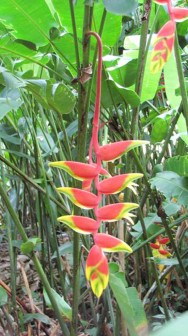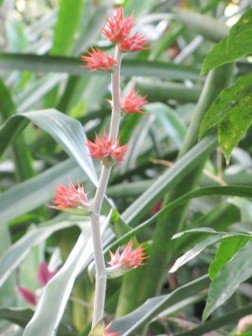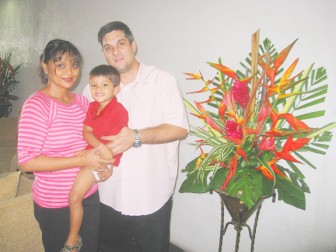By Bobby Walker
It is 11:30 on a humid Friday morning. Three-year-old Jonathan Ramsaroop is sitting in the backseat of the vehicle happily sucking on his thumb.
In the front seat, his parents are talking into the speaker phone. The woman on the other line, a regular customer, is ordering a special bouquet as a welcoming present for her family, and would like it to be delivered to her house, just outside Georgetown. Of course this is no problem. The Ramsaroops do free delivery around Georgetown but don’t fuss about driving a few extra miles.
Gerhard and his wife Michelle own and manage Double ‘B’ Exotic Gardens, a flower shop with a reputation for creating striking arrangements using all local flowers. Michelle is the genius behind the beautiful designs.
They have only been running the business officially for a month and a half but the Ramsaroops are certainly not novices.

With the radio playing softly in the background, Gerhard talks about how his parents’ business started.
When his father, Boyo Ramsaroop, was a teenager, he took a gardening course at the Botanical Gardens where he fell in love with plants. At the time he was also working as an electrician.
At the age of 24 he left for Germany on a PPP scholarship to study electrical engineering. He returned to Guyana in 1970 and began working as an electrical engineer. However, that career was short lived. Around 1980, when Forbes Burnham built Congress Place, he asked Boyo to do the wiring for the building, Boyo refused saying that it was a misuse of taxpayers’ money.
Suddenly, all the contracts he had with the government were abruptly cancelled. Unemployed, he formed Double ‘B’ Gardens with his German wife, Bridgette. Together they started doing landscaping and floral arrangements. Bridgette later became one of Guyana’s most well-known florists.
Now, 30 years later, Boyo’s business, reputation and legacy still survive. Even his death in August of 2010 and his wife’s prior return to Germany in 2008, did not see it close.
Gerhard left off working in the computer industry and along with his support team, Michelle and Jonathan, went full throttle into running his family’s business.

Gerhard says he has been farming since his was seven, right after his family moved to Lamaha Gardens. Over the years he has developed a close connection to the soil, which is hard to give up.
The business, now located at their home in Alexander Village, is run by Michelle and Gerhard. One staff member, Shamela, helps Michelle with prepping and arranging the flowers. Anil, who Gerhard says is more like a partner than an employee, oversees the two farms; five men work on both of the farms.
Every Wednesday and Saturday, Gerhard and Michelle go to their farms to collect flowers. They also collect flowers on other days when there are special deliveries to be made and occasions to be catered for.
On days like Mother’s Day and Valentine’s Day, arrangements are made extra-special with the addition of appropriate decorations that are imported. Gerhard says they try to keep the import levels low and to use almost all local products. They use locally made baskets to transport flowers around during delivery.
Farms
Their first farm is located on the first hill of the Linden-Soesdyke Highway. It is a 34-acre property.

There is an old, beat-up truck lying around 30 feet away from where the car is parked. The truck has been there for a while and blades of grass have already grown around its contours. The wheels are gone and the windscreen is now opaque from dirt. Gerhard says it is a German-made truck and calls it a beauty. Michelle rolls her eyes when he says that the truck can easily be fixed. He sees its potential and has already figured out ways to fix up the “brukka-dung” truck. It is interesting that Gerhard manages to see the possibilities behind all the rust and dirt. It is evident from other conversations with him that Gerhard feels the same way about Guyana. He believes in hope, and like all horticulturists, has the patience to wait until it is time to blossom.
Michelle and Jonathan wait in the car while Gerhard and Anil give a tour of the farm. There is an old bus next to a tree. The bus is occupied by the plants and vines that have grown freely. Gerhard says they plan to clear all the vines out and use the bus as a nursery. Further up rows of plants sit snugly in the ground under a dark tent. Parts of leaves that have been affected by a bacterial infection are visible, but there are not many infected leaves left. The infection, they suspect, was caused by their use of fresh chicken mole. Gerhard says that the Ministry of Agriculture has been very helpful in removing the infection and testing the soil.
The floor is covered in yellow spots from the sunlight that is sneaking its way through the leaves of the over-head tree. Under the trees are rows of purple cordylines, standing as tall as Anil.
Gerhard walks forward and clears a space between large, green plants. Beautiful yellow flowers (Spectabilis) stick out among the vastness of green. Anil cuts three of them. Michelle will use them in her bouquet. Also peeking out from the green are striking bright orange Heliconias.
The men lead the way around 100 feet from where the flowers are to check on the other small plants. They are talking about business and are also obviously very familiar with the area since they seem to be able to walk with ease on the uneven ground.
Gerhard talks about his plans for opening a small resort on the farm some time in the future. He says he would like a resort that is environmentally friendly and one where people are not allowed to kill the wildlife or play loud music. It would be a place for families.
On the ground there are awaras scattered all about. Some look as if they have been picked and put in bundles.
Gerhard points to various flowers. There are more ginger lilies but some of them are red, some are yellow while some are green. There are other flowers which he calls by their scientific names. When asked how he remembers all the names, he laughs and says “Is the old man drill them into my head.”
The second farm is behind the airport. Michelle says that, when it rains, some days the trail to the farm is impassible but thankfully one generous man allows them to take a short cut through his private property.
This 170-acre property, which Jonathan calls the “big farm”, was previously called Arawak Resort. The farm was given to Boyo by Adrian Thompson, the famous mountaineer who led the climb to Mount Ayanganna on Guyana’s first Independence. Thompson saw the passion Boyo had for plants and felt he was entrusting the farm into good hands. In the farm’s heyday, there were up to 80 different varieties of Heliconias.
The Ramsaroops have sold this farm to a private resort but they have an agreement where Gerhard and Michelle can keep things on for three years until they would have moved all operations to the smaller farm. The car passes through a dark trail and large leaves brush the sides. Every once in a while Bromeliads peek out from behind the plants, almost like they are scared and hiding from anyone unfamiliar. But the scared flowers are still hard to miss with their bright red spikes.
The car comes to a slow stop in front of a big, unpainted concrete house. There are pieces of wood lying on the floor and under a sharp ray of light, dust particles are drifting and bumping into each other. Three men are working at breaking down the house in separate pieces, which they will move to the other farm. This was Gerhard’s home when he was a teenager. He opens the garage door and a loud symphony of flapping begins. There are bats flying all about the ceiling. “Doan worry. Is Friday, dey nah gun bodda yuh,” says one of the men.
Michelle puts on Jonathan’s ‘long boots’. Everyone sets off up a gentle hill to pick the rest of the flowers. Along the way Gerhard points out unusual yellow orchids that grow in the ground. Further up there is a thick wall of heliconia leaves. Gerhard says that snakes like to lie under to leaves that have fallen, but not to worry, when they feel the vibration of your footsteps, they hide. Michelle pulls out her gardening shears and begins to look for the pink tulip gingers for the bouquet. She cuts one and hands it to Jonathan who is happy to help his mother. But after the third ginger lily is in his hand, it becomes too heavy and he begins to drag them on the ground.
It begins to rain and everyone runs for shelter under the biggest of the Heliconia leaves. Michelle says the weather is extreme and can go from blistering sunshine to rain in a matter of seconds.
After a few minutes, the rain still hasn’t stopped. Instead it is falling harder and so Gerhard tells Michelle to take Jonathan back to the car while he picks the Heliconias for the arrangement.
Gerhard walks back to the car with his hands full of flowers and puts them into the nibbi basket in the trunk. In the car, the smell of the flowers is still very high.
It’s getting late and everyone is hungry. Gerhard talks to the men working on the house for a few quick minutes and then he gets back into the car and starts to drive on the bumpy trail.
On the long drive down on the East Bank, Gerhard Ramsaroop is effusive in explaining his vision for Guyana. His is the horticulturalist’s perspective, the hard-won cultivation of supreme beauty blooming in a half-formed space while at the same time rooting out that which is ugly.
Its late afternoon and the hue of the colours in the sky becomes deeper and denser. Jonathan sits in the back seat tearing the flower he picked up from the farm. Maybe one day, he will follow in his father’s footsteps.
Back at their home in Alexander Village, Michelle puts together the arrangement. She takes out a long strip of green floral foam. She cuts the foam in half with her knife, making a loud, screeching sound. She places one part into a bucket of water. When it is thoroughly soaked, she tapes it to a small round tray.
First, Michelle trims 3 sugar cane palms and places them at the back of the foam. Then she takes Dracaena leaves, folds them and sticks those in as well. The leaves make a soft whooshing sound as they slice through the floral foam. Michelle then cuts the thick stems off the tulip and shampoo gingers and places them in the middle of the base. This has become second nature to her and she says she can make large arrangements in under an hour. Michelle says that one of the luxuries of working from home is that they can be open everyday but it is still not demanding on their personal lives. “If someone needs a last-minute arrangement, I can just run downstairs and get it down quickly.”
Michelle jabs the Heliconia into the middle of the foam and then uses the pink tulip gingers to surround it. When she first started doing floral arrangements in May, she thought she had to be very gentle with the flowers but she soon realized that the flowers they use are much stronger than carnations and roses and do not damage easily. That’s why, she says, these flowers travel well and last a very long time.
She uses three Spectabilis flowers and positions them carefully. Then she uses tulip ginger leaves and Dracaena to fill the holes and hide the foam. The arrangement is finished in under 20 minutes. It is beautiful and simple.
Gerhard and his wife have the gardener’s broad faith; the fixed belief in the continuity of life. They also possess the same fidelity to tedious, inescapable detail. Like their flower farms do in every season, they have faith that the country will some day blossom. In the meanwhile, what they do is focus on the minutiae of cultivation, of growth, and in this case- to deliver the customer’s bouquet before 6 o’clock.





